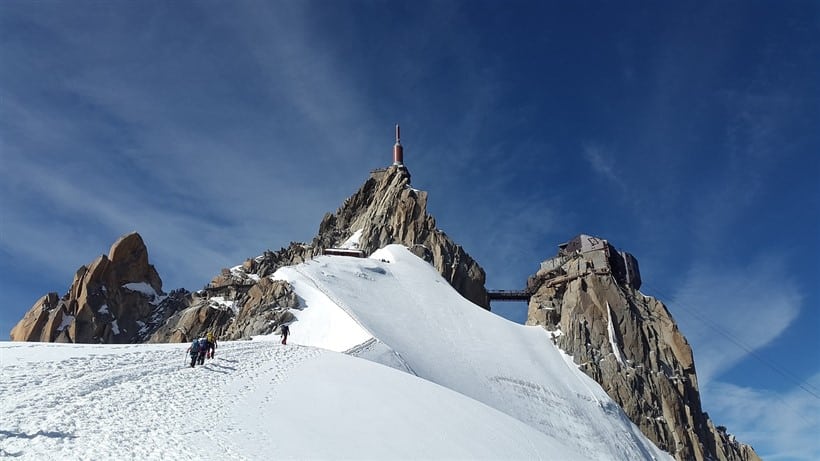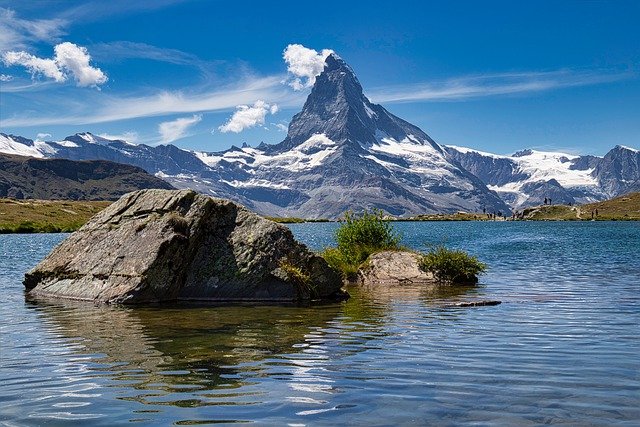Posted on 02 January 2023
The highest alpine peaks reflect the brilliance and elegance of Mother Nature across three countries. Often attracting many mountain climbers and becoming hubs of winter sports, the highest peaks are a world away from urban living. The Alps Mountain range belonging solely to Europe stretches for 750 miles across the alpine countries of France, Switzerland, Italy, Liechtenstein, Austria, Germany, and Slovenia. Formed over millions of years, the unique climate, topography, flora and fauna make it one of the world’s most exciting destinations, even for those who don’t like to climb the peaks. Of course, the French alps are the most popular skiing destination in the world, but for those who dream of mountain living, the alps offer much more. So, let’s look at the tallest peaks, main mountain ranges, and towns.
10 of the Highest Alpine Peaks
1: Mont Blanc – Highest Peak in the Alps
The majestic Mont Blanc stands at a staggering 4,804 meters above sea level and stretches across Switzerland, Italy and France. Known for stunning Alp glaciers, the Tour du Mont Blanc is also one of the world’s most popular hiking trails. Mont Blanc massif sits on the French Italian alps border, although the northern tip of the mountains runs to Switzerland. In France, Mont Blanc is the King Peak in the alps, and as the highest mountain in the alps draws in worldwide fame. Famous glaciers on Mont Blanc include Glacier des Bossons, Bionnassay Glacier and dome glacier. Read more about the Mont Blanc mountains and peaks in the alps.

2 – Monte Rosa Massif – Switzerland’s Highest Peak
Four Alp peaks of Monte Rosa mountains fit into the highest mountain category: Dufourspitzeis the highest peak at 4634 meters, Dunabrspitze at 4632 meters, Grenzgipfel, the third most prominent peak at 4618 meters, and Nordend at 4609 meters. Monte Rosa mountain range attracts hikers, skiers, and snowboarding because the high alps altitude is a surefire bet for good snowfall.
Numerous ski resorts in Monte Rosa are suitable bases for exploring, and most are also summer ski resorts. The western part of the Monte Rosa massif also taps into the Zermatt ski area. At the same time, other places to go are Macugnaga, Alagna Valsesia, Gressoney and Champoluc on the eastern Alps face of Monte rosa. Like the Mont Blanc massif, there is a specific trekking route called the Tour de Mont Rosa that takes in main highlights, which takes about ten days to finish while crossing several valleys.
3: Dom Mountain Range in Switzerland
Standing at 4,545 meters above sea level, the Dom belongs to the Pennine Mountain range in the Valais canton of Switzerland. Known as Switzerland’s second-highest peak and the Alp’s third tallest peak, the first ascent was done in 1858, and the first ski ascent was in 1917. The normal route takes two days, and a mountain guide is a must. A good starting point for any climb of the mountains is the Dom hut at 2940 meters, run by the Swiss Alpine Club, who kitted it out with everything modern trekkers in the Swiss Alps need. The cabin is the famous starting point for several ascents of nearby mountains.
4: Liskamm
Standing at 4,527 meters above sea level, the Liskamm is also in the Pennine Alps on the border of Italy and Switzerland. First climbed in 1861, the peak is also known as Silberbast. Be aware, though, because its nickname is people eater – Menschenfresser referring to the difficult climb. Many Alp mountaineers have lost their lives. While the southern side rises only a few hundred metres above the glacier, the ice-covered northern wall reaches for an impressive 1000 meters. Hikers start at the route at either the Monte Rosa hut at 2883 meters or the Gnifetti hut at 3650 meters and then follow the same route as the first ascent in 1861.
5: Weisshorn in Switzerland
Sitting near Matterhorn in the Pennine, the Weisshorn at 4506 meters attracts only the hard-core climbers with experience thanks to the difficulty level. Belonging to the Pennine Alps and sitting between the Anniviers and Zermatt Valleys in the Valais canton, the first climb in 1861 cemented its reputation as the Alp’s most beautiful mountain range. However, despite the beauty, Weisshorn is also known for challenging Alp climbs, with the standard route starting at Weisshorn Hut.
6: Matterhorn – The Sixth Highest Peak
The Swiss Alp’s most photographed mountain stands at an incredible 4478 meters. Hence, the nickname “mountain of mountains” never fails with dramatic plateau views quite unlike anywhere else in the world. The closest town to Matterhorn is Zermatt, which hosts thousands of visitors every year, who flock to see the mountain standing tall in the distance. Various trekking routes range from a day to 12 days, and despite the popularity, take along a mountain guide if the Matterhorn is your target goal in Switzerland.

7: Dent Blanche
Also sitting in the Zermatt region, Dent Blanche stands at 4,358 meters high and is one of the most difficult alpine peaks to climb. Therefore, good acclimatization and fitness levels are needed. The ice-free pyramid with four ridges is best climbed from July to September, and a popular route is 6 hours of hiking from Ferpècle to La Dent Blanche Mountain hut at 3507 meters, then up to Wanfluelücke and the south ridge to head to the highest peaks.
8: Grand Combin Mountain Massif in Switzerland
Sitting in the Western Pennine Alps at 4314 meters, the Grand Combin was first climbed in 1859, but the mountain also presents many difficulties, like avalanches and icefall. There are several summits, three above 4000 meters, and the most favoured hiking route starts from the Panossière Hut at 2641 meters on the north side. The two other huts are Valsorey Hut at 3,030 metres on the southwest side and Bivouac Biaggio Musso hut at 3,658 meters on the south side. The best time to climb is from March to September, and you need good fitness levels. However, this showcases exceptional flora and fauna for nature lovers.
9: Finsteraarhorn in the Bernese Alps of Switzerland
The Finsteraarhorn, at 4,274 meters, stands tall and proud but doesn’t feature highly on the list of places to hike. However, it does attract many skiers. Lying between the Bern and Valais Cantons, the Finsteraarhorn also belongs to the Jungfrau-Aletsch world heritage site. Hikers have two huts to take advantage of the Finsteraarhorn Hut and Oberaarjoch Hut. The Finsteraarhorn is the tallest peak of the Bernese Alps. For those who like a combination of skiing, cross-country routes and hiking, a three-day tour ends up in the Bachilucke peak, with a fantastic descent down to Reckingen.
10: Zinalrothorn
Zinalrothorn, at 4,221 meters, sits between the Matterhorn and Weisshorn. First climbed in 1864, the name stems from the Zinal village on the north side and the German word for red peak. The other nearby villages include Tasch and Zermatt. Famous for two glaciers on the western foot of the mountain, the Zinal glacier and the Moming glacier, the easiest route is on the southeast ridge.
What Mountains are in Central France?
The Massif Central features many mountains and alpine plateaus that makeup roughly 15% of France. Standing at 1,886 metres and covering 184,000 square meters, the massif central includes the regions of Auvergne-Rhône-Alpes, Bourgogne-Franche-Comté, Nouvelle-Aquitaine and Occitania. The highest peak is Puy de Sancy.
Also, About the Alps
Chamonix Valley: They are the central mountain ranges and the highest peak in the alps, but there is much more to know than hiking. Chamonix-Mont-Blanc is a famous ski resort in eastern France, which is an idyllic winter wonderland at the junction of France, Switzerland and the Italian alps. It is one of France’s oldest ski resorts with unbelievable picturesque views of mountain ranges of natural beauty. Sat at the foot of Mont Blanc, year-round cable cars head to the nearby peaks of Aiguille du Midi and Pointe Helbronner on the Italian border. Chamonix is definitely a good place from which to explore peaks in the Alps.

